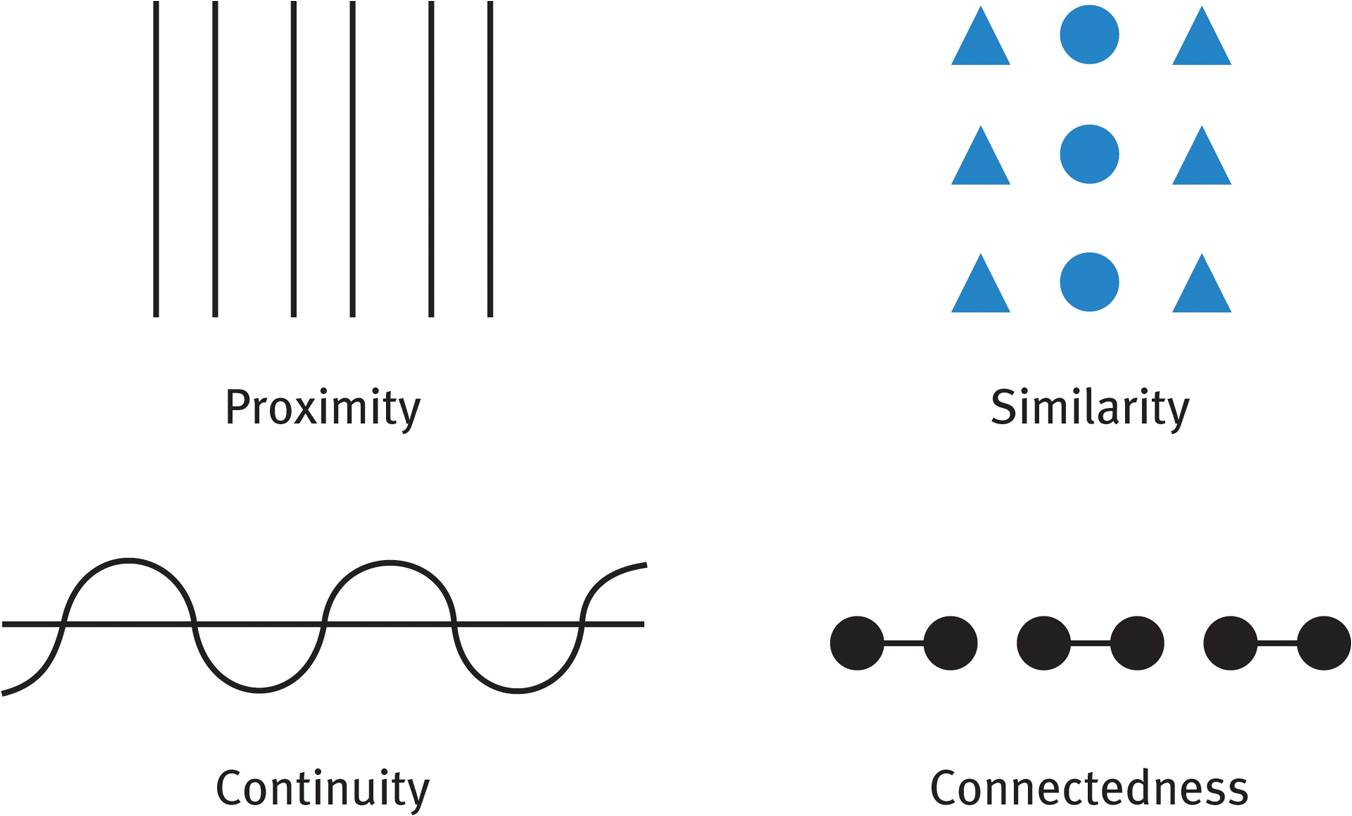


Name (4 points each) and describe (8 points each) each of the Gestalt Principles illustrated above (60 points total):
We will write a custom essay on your topic a custom Essay on Gestalt Principles of Perception
808 writers online
| 1. Principle of Proximity According to this principle objects that are placed close to each other are peceived to be together as one as opposed to the objects that are spaced further apart (Sternberg, Mio, & Mio, 2008). In Figure 1 the line that are situated close to each other are more likely to be viewed as one unlike the lines that have a greater space between them. The first two lines can be seen to have some relationship since they are close to each other. The second and the third line which are further from each other are not likely to be associated. | 2. Principle of Similarity This principle states that the objects that have similar characteristics be it shape, texture, size or value will be perceived to be belonging together (Sternberg, Mio, & Mio, 2008). The objects in Figure 2 are portrayed as having some similarities and are like to be associated in the process of percetion. Since the objects are of the same colour, are small in size and can be defined as shapes, they will be percieved to be related. A person is more likely to describe the illustration in terms of triangles and circles than in terms of columns and rows. |
| 3. Principle of continuity This principle states that human beings have a preference for continued figures in perception. Objects that may not be sequential are perceived to be sequential (Levitin, 2002). In Figure 3 the likely perception will be the one where a straight line is intercepting a curvilinear one, than semi circles placed against each other. The various objects are seen as a continuous while in real sense they could be independent but touching. | 4. Principle of Closure This principle states that objects that simple figure which do not have continuity or similarity are seen to be touching or closed (Sternberg, Mio, & Mio, 2008). Figure 3 presents sets of two circles that are joined by a straight line. According to Gestalt’s principle of closure, there is a great likelihood of viewing the whole figure as many circles joined by a single line. The discontinuity of the line between may be ignored by most human beings. |
| 5. Principle of Common Fate This principle states is used to perceive the objects that are in motion. The objects that are close together and those which have similar characteristics are grouped together. The objects that seem to be moving in the same direction are perceived first then the other objects that are moving in different directions are perceived upon further observation (Levitin, 2002). Figure 5 will most likely be perceived as people running while holding hands. Most people will not perceive it as two sets of arrows facing opposite directions. As explained above human beings have the tendency of perceiving objects according to their direction in movement and since the people are moving in one direction, they will be perceived first. The arrows moving in opposite directions will be perceived subsequently and by few people due to their differing direction of movement. | |
| Choose one of the illustrations (by number and name) and explain how top down and/or bottom up processing might apply in interpreting that principle (20 points). Top down processing involves the use of data provide in the context in recognition of pattern. The data presented is viewed as a whole and not the various parts that make it. This is because; the context in which data occurs is useful in its understanding and perception (Nevid, 2011). The principle of continuity which is presented in Figure 3 states that human beings have a tendency of perceiving objects as continuous or whole. The many parts that make the object are ignored in its perception and the bigger part that they appear to make perceived. The data presented in Figure 3 is easier to perceive as a straight line intercepting a curvilinear one rather than semi circles placed against each other. If the context of the same data changed and the semi circles stopped touching then they would be easy to perceive since they would now become wholes. The arcs and line joining them would then be their parts that can only be perceived easily upon further disintegration of the figure. In reading, there is a high tendency of perceiving words depending on the meaning they achieve in their use. In inferencing, meaning of the word is derived from the context in which it is used. The sentence in which it appears is considered as a whole and not just the single word. | |
| Compare and contrast the processes of sensation and perception (what are the similarities and differences) and explain how they work together (20 points). Sensation is the process through which data is collected from the environment through the sensory organs and relayed to the brain upon stimulation. Perception, on the other hand, is the process through which the data sent to the brain is analyzed, organized and interpreted (May, 2007). Similarities of perception and sensation include;
Differences between perception and sensation include;
Sensation and perception can not be separated since there are very crucial to each other. Perception is the continuation of sensation to form experiences thus sensation without perception would not make sense. In the stimulus-response process that both processes are part of, sensation relays the stimulation and perception creates the response. | |
References
| |